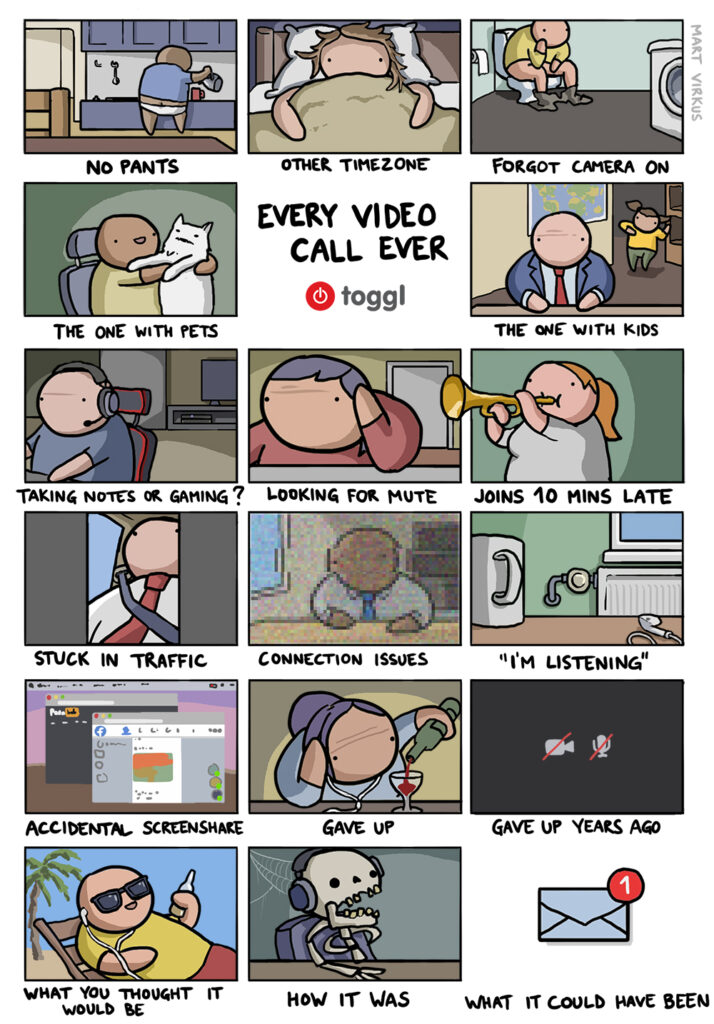Hacker hacken… Türkische Moscheen und deren Minarette, um auf den Lautsprechern der Einrichtungen “Bella Ciao” anstelle der üblichen Gebete zu spielen.
Dem Nachrichtensender N-TV zu Folge ein Angriff von türkischen Hackern.
Hacker hacken… Türkische Moscheen und deren Minarette, um auf den Lautsprechern der Einrichtungen “Bella Ciao” anstelle der üblichen Gebete zu spielen.
Dem Nachrichtensender N-TV zu Folge ein Angriff von türkischen Hackern.
Since COVID-19 let’s us work from home, we all made our experiences with Videoconferences. The tools make it possible to work from home, yet some still have to get used to the new freedom. We all know the feeling in these conferences, with colleagues listening or not, playing with their pets, kids or Zoom Backgrounds. Toggl, maker of fantastic time tracking software, nails it:

For those bored in isolation, you can now build your own vintage computer. From paper. Following the instructions from Rocky Bergen, an artist and designer. Should work well with kids, too!

Link: Papercraft.
“Health Officials Say ‘No Thanks’ to Contact-Tracing Tech“, titles Wired. In all these recent debates about how to handle Covid-19 going forward, in particular in Germany, it may be worthwhile looking beyond borders.
Later last month, Engadget reported, that Israel stops phone tracing to enforce Corona quaranties. While Israel seemed to look at phone location information, the Wired article suggests multiple US states and cities evaluated the benefit of other contact tracing technology. The result seems to disappoint:
States like New York, California, and Massachusetts, and cities like Baltimore and San Francisco, have looked carefully at cutting-edge contact-tracing solutions and largely said, “No thanks,” or “Not now.”
via wired.
Foreign perspective is an interesting one, too. Foreign Policy titles “Germany’s Angst Is Killing Its Coronavirus Tracing App“. Which, after all, may be the exact outcome.

Tag 50 der Corona-Isolation – Sport ist weiterhin erlaubt. Den Tag der Arbeit ganz ohne Arbeit am Strand des Starnberger See verbracht, mit dem Rennrad dorthin. Während Bayern erst vergangenen Donnerstag eine Verlängerung der Ausgangsbeschränkung angekündigt hat, stellt sich deutlich eine Sehnsucht nach Normalität her. Trotz aller Notwendigkeit, die Situation in den Griff zu bekommen.
Bruce Schneier, well known cryptologist and security researcher, has a few thoughts on corona tracing apps on his blog. Spoiler: he doesn’t like the idea.
His article is revolving around efficiency much more than privacy, concluding that such apps won’t work in the first place.
CloudFlare extends it’s presence in China through partnering with JD Cloud & AI. The company is currently present in 17 datacenters in mainland China. Cloudflare maintains a partnership with Baidu, through that recently announced partnership the Cloud vendor can leverage 150 more datacenters and therefore vastly extend it’s footprint in the region.

Mobility Woche hier im Blog. Wo überall Sharing Bikes so rumstehen. Nachdem die Mobilitätsbranche in Deutschland in allen Ihren Ausprägungen stillsteht, stehen auch die Fahrräder in der Gegend rum. Noch mehr als vor COVID-19.
Breakthrough of Digital Culture: Finland accepts the Demoscene on its national UNESCO list of intangible cultural heritage of humanity.
“Demoskene is an international community focused on demos, programming, graphics and sound creatively real-time audiovisual performances. [..] Subculture is an empowering and important part of identity for its members.”
Source: Demoscene – The Art of Coding
Github is on a spree to get hold of the entire developer ecosystem. Offering the service for free to all teams, it’s difficult for any development team to ignore the Microsoft based platform.
GitHub today announced that all of its core features are now available for free to all users, including those that are currently on free accounts. That means free unlimited private repositories with unlimited collaborators for all, including teams that use the service for commercial projects, as well as up to 2,000 minutes per month of […]
Techcrunch
via: TechCrunch